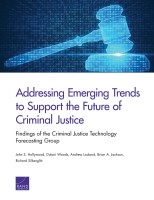| 来源类型 | Research Reports
|
| 规范类型 | 报告
|
| DOI | https://doi.org/10.7249/RR1987
|
| ISBN | 9780833099051
|
| 来源ID | RR-1987-BJA
|
| Addressing Emerging Trends to Support the Future of Criminal Justice: Findings of the Criminal Justice Technology Forecasting Group |
| John S. Hollywood; Dulani Woods; Andrew Lauland; Brian A. Jackson; Richard Silberglitt
|
| 发表日期 | 2018
|
| 出版年 | 2018
|
| 页码 | 68
|
| 语种 | 英语
|
| 结论 |
A Lack of Business Cases, Implementation Processes, and Security, Privacy, and Civil Rights Knowledge Hamper IT Opportunities- Few know how to use and acquire many of the new technologies efficiently and effectively. Few know about the security, privacy, and civil rights protections needed to employ them safely.
Business Cases and Processes for Technologies Are Lacking- Business processes for operationalizing new technologies are lacking.
Big Data and Analytics Are Emerging- The emergence of analytics, big data, and situational awareness displays, devices, and data streams offers substantial opportunities, barriers, and risks for the criminal justice community.
Security, Privacy, and Civil Rights See Challenges from New Technologies- Cybersecurity protections and investigations are increasingly needed.
- Emerging surveillance technologies require new legal foundations.
- Increasing commercial pressures on unbreakable encryption might be hampering criminal investigations.
The Field Needs to Get to Criminal Justice Community–Wide Integration- Information must be integrated and shared, and digital evidence must be managed on a massive scale, if the field is to systematically benefit from new technologies.
Safety and Community Relations Need Research and Development to Improve- Agencies are facing pressures to adopt community-based models of law enforcement while pressure also mounts to crack down on violence and terrorism. Accountability, body-worn cameras, and improved less-lethal weapons are needed.
New Technologies Bring New Challenges- Implementing new technology, such as touch and rapid DNA and remote weapon detection, could have serious and unintended consequences but also major and unanticipated benefits.
|
| 摘要 |
- Develop common business cases and process templates for operationalizing new technologies.
- Conduct research to improve how criminal justice technology information is made available to both practitioners and researchers.
- Integrate security, privacy, and civil rights protections into the common business processes for adapting new technologies.
- Educate the public on how criminal justice technologies work or (do not work) in the real world.
- Collect data on the going-dark problem of investigators being unable to access devices with strong encryption.
- Research how to change organizational cultures to support information-sharing and safeguarding.
- Develop regional and shared-services models for information-sharing capabilities.
- Identify practices and technologies that can both reduce crime and improve community relations.
- Explore exchanges with international partners on how to use cameras for investigative and accountability purposes.
- Develop new immobilization and restraint devices to provide alternatives to lethal uses of force.
- Assess the potential of remote weapon-detection capabilities.
|
| 主题 | Big Data
; Civil Rights
; Communication Technology
; Criminal Justice
; Emerging Technologies
; Law Enforcement
|
| URL | https://www.rand.org/pubs/research_reports/RR1987.html
|
| 来源智库 | RAND Corporation (United States)
|
| 引用统计 |
|
| 资源类型 | 智库出版物
|
| 条目标识符 | http://119.78.100.153/handle/2XGU8XDN/108794
|
推荐引用方式
GB/T 7714 |
John S. Hollywood,Dulani Woods,Andrew Lauland,et al. Addressing Emerging Trends to Support the Future of Criminal Justice: Findings of the Criminal Justice Technology Forecasting Group. 2018.
|
|
文件名:
|
x1529943492726.jpg
|
|
格式:
|
JPEG
|

|
文件名:
|
RAND_RR1987.pdf
|
|
格式:
|
Adobe PDF
|
除非特别说明,本系统中所有内容都受版权保护,并保留所有权利。